Not Dogs: Innovation, Commercialization, and Business Development
VerifiedAdded on 2024/05/31
|26
|5287
|391
Report
AI Summary
This report provides a comprehensive analysis of innovation and commercialization strategies within the context of 'Not Dogs,' a small business venture focused on providing vegetarian fast food. It begins by defining innovation and highlighting its importance to organizations, contrasting it with invention. The report then explores how organizational vision, leadership, culture, and teamwork shape innovation and commercialization. Different sources of innovation are analyzed, and methods for fostering an innovative environment are discussed. The 4P's of innovation are examined, along with the use of the innovation funnel to shape innovative ideas in 'Not Dogs'. Furthermore, the developments and roles of frugal innovations are explored, followed by the importance of the commercial funnel and new product development processes. The report also discusses building an innovation business case, including accessing funding, and evaluates various tools for developing, retaining, and protecting knowledge and intellectual property, providing an evidence-based evaluation within the wider business environment. The report concludes by summarizing the key findings and their implications for 'Not Dogs' and similar businesses.
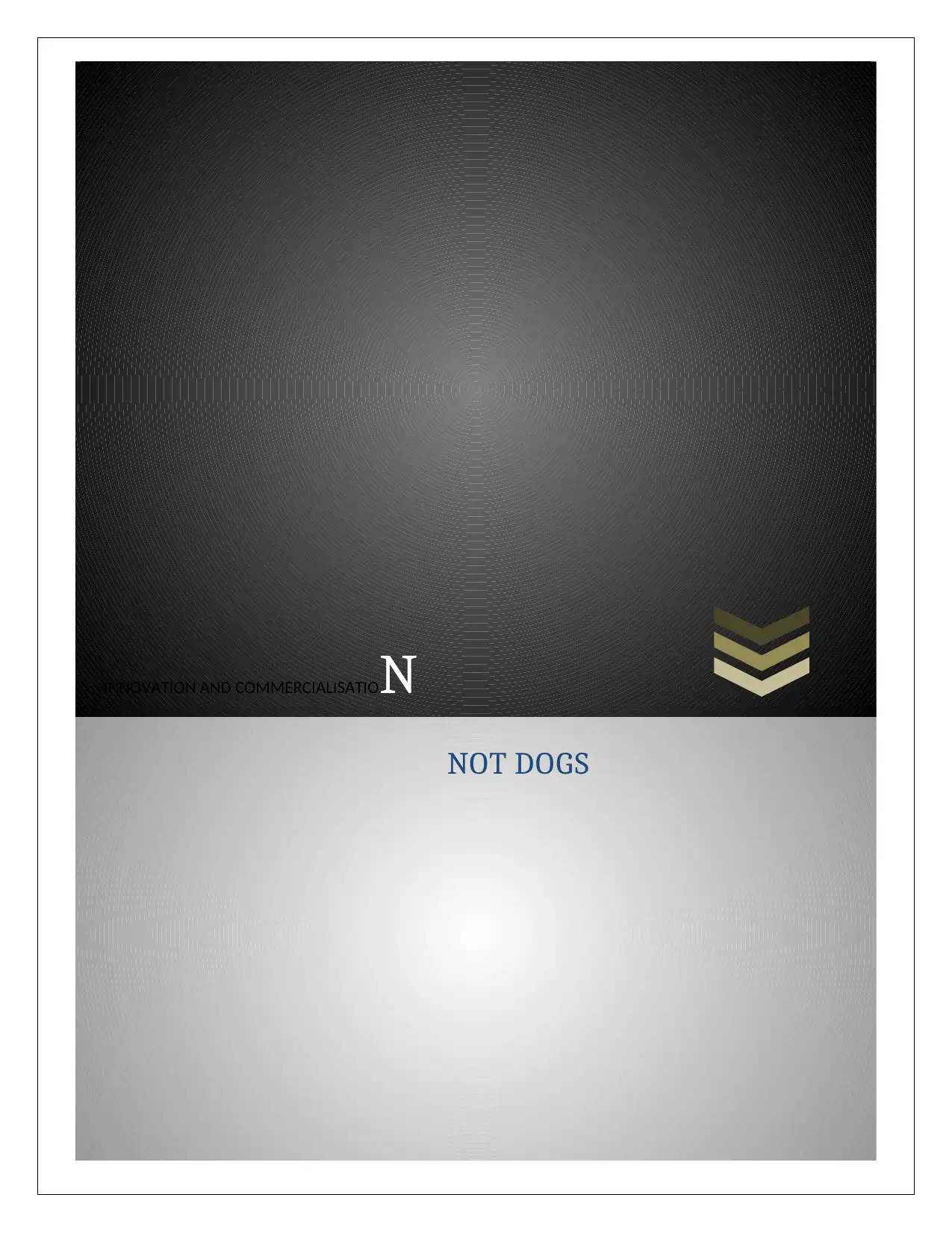
INNOVATION AND COMMERCIALISATION
NOT DOGS
NOT DOGS
Paraphrase This Document
Need a fresh take? Get an instant paraphrase of this document with our AI Paraphraser
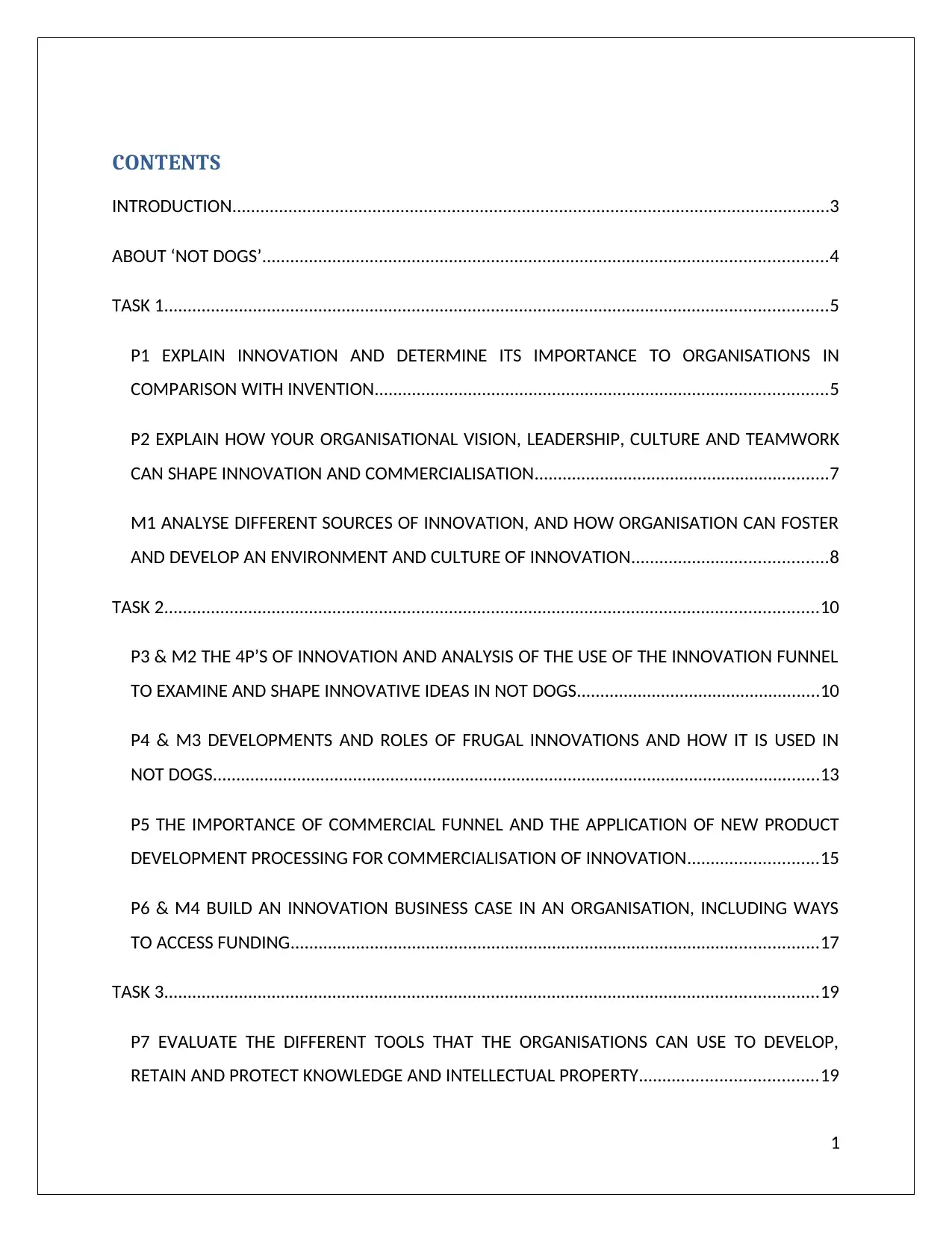
CONTENTS
INTRODUCTION................................................................................................................................3
ABOUT ‘NOT DOGS’.........................................................................................................................4
TASK 1..............................................................................................................................................5
P1 EXPLAIN INNOVATION AND DETERMINE ITS IMPORTANCE TO ORGANISATIONS IN
COMPARISON WITH INVENTION.................................................................................................5
P2 EXPLAIN HOW YOUR ORGANISATIONAL VISION, LEADERSHIP, CULTURE AND TEAMWORK
CAN SHAPE INNOVATION AND COMMERCIALISATION...............................................................7
M1 ANALYSE DIFFERENT SOURCES OF INNOVATION, AND HOW ORGANISATION CAN FOSTER
AND DEVELOP AN ENVIRONMENT AND CULTURE OF INNOVATION..........................................8
TASK 2............................................................................................................................................10
P3 & M2 THE 4P’S OF INNOVATION AND ANALYSIS OF THE USE OF THE INNOVATION FUNNEL
TO EXAMINE AND SHAPE INNOVATIVE IDEAS IN NOT DOGS....................................................10
P4 & M3 DEVELOPMENTS AND ROLES OF FRUGAL INNOVATIONS AND HOW IT IS USED IN
NOT DOGS..................................................................................................................................13
P5 THE IMPORTANCE OF COMMERCIAL FUNNEL AND THE APPLICATION OF NEW PRODUCT
DEVELOPMENT PROCESSING FOR COMMERCIALISATION OF INNOVATION............................15
P6 & M4 BUILD AN INNOVATION BUSINESS CASE IN AN ORGANISATION, INCLUDING WAYS
TO ACCESS FUNDING.................................................................................................................17
TASK 3............................................................................................................................................19
P7 EVALUATE THE DIFFERENT TOOLS THAT THE ORGANISATIONS CAN USE TO DEVELOP,
RETAIN AND PROTECT KNOWLEDGE AND INTELLECTUAL PROPERTY......................................19
1
INTRODUCTION................................................................................................................................3
ABOUT ‘NOT DOGS’.........................................................................................................................4
TASK 1..............................................................................................................................................5
P1 EXPLAIN INNOVATION AND DETERMINE ITS IMPORTANCE TO ORGANISATIONS IN
COMPARISON WITH INVENTION.................................................................................................5
P2 EXPLAIN HOW YOUR ORGANISATIONAL VISION, LEADERSHIP, CULTURE AND TEAMWORK
CAN SHAPE INNOVATION AND COMMERCIALISATION...............................................................7
M1 ANALYSE DIFFERENT SOURCES OF INNOVATION, AND HOW ORGANISATION CAN FOSTER
AND DEVELOP AN ENVIRONMENT AND CULTURE OF INNOVATION..........................................8
TASK 2............................................................................................................................................10
P3 & M2 THE 4P’S OF INNOVATION AND ANALYSIS OF THE USE OF THE INNOVATION FUNNEL
TO EXAMINE AND SHAPE INNOVATIVE IDEAS IN NOT DOGS....................................................10
P4 & M3 DEVELOPMENTS AND ROLES OF FRUGAL INNOVATIONS AND HOW IT IS USED IN
NOT DOGS..................................................................................................................................13
P5 THE IMPORTANCE OF COMMERCIAL FUNNEL AND THE APPLICATION OF NEW PRODUCT
DEVELOPMENT PROCESSING FOR COMMERCIALISATION OF INNOVATION............................15
P6 & M4 BUILD AN INNOVATION BUSINESS CASE IN AN ORGANISATION, INCLUDING WAYS
TO ACCESS FUNDING.................................................................................................................17
TASK 3............................................................................................................................................19
P7 EVALUATE THE DIFFERENT TOOLS THAT THE ORGANISATIONS CAN USE TO DEVELOP,
RETAIN AND PROTECT KNOWLEDGE AND INTELLECTUAL PROPERTY......................................19
1
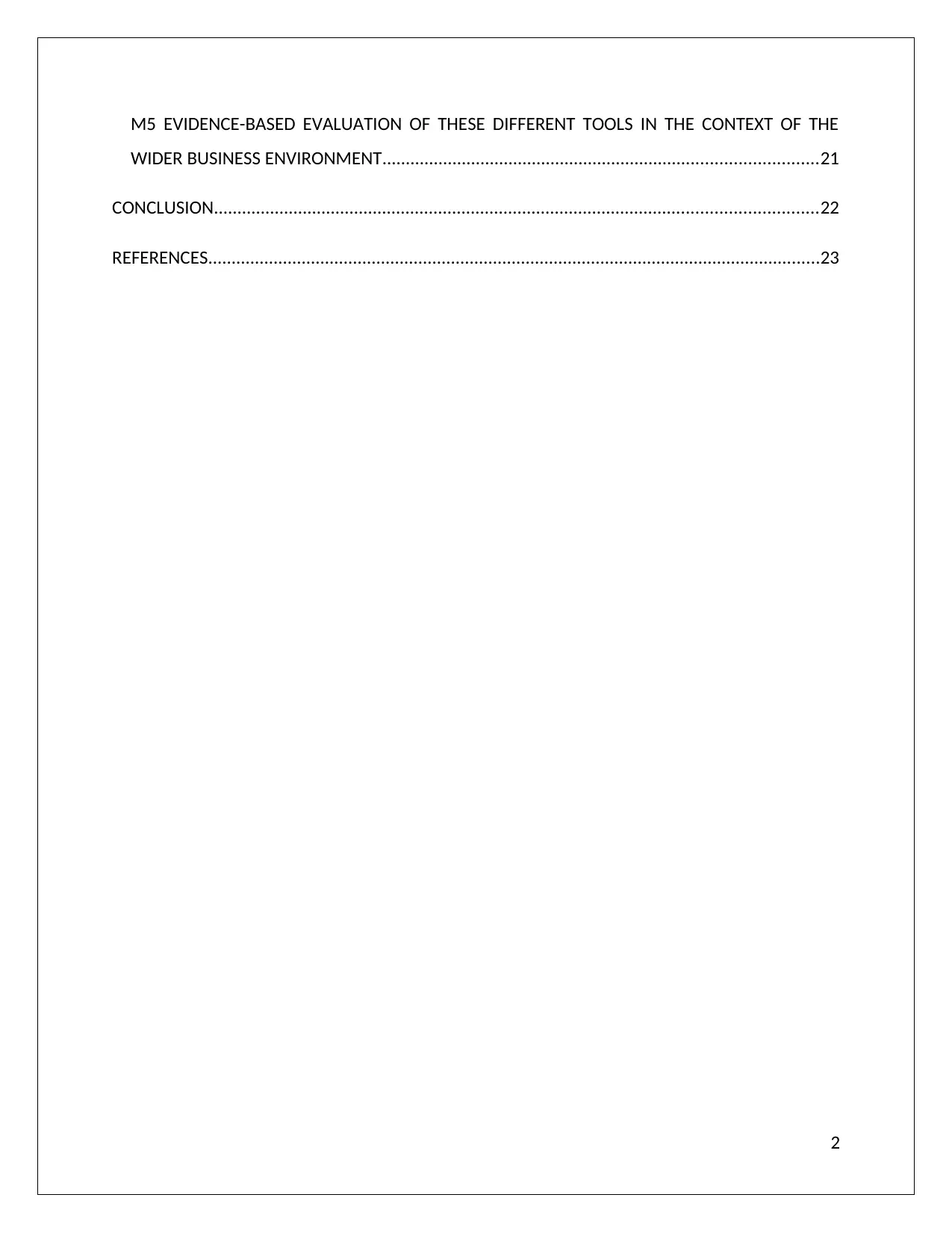
M5 EVIDENCE-BASED EVALUATION OF THESE DIFFERENT TOOLS IN THE CONTEXT OF THE
WIDER BUSINESS ENVIRONMENT.............................................................................................21
CONCLUSION.................................................................................................................................22
REFERENCES...................................................................................................................................23
2
WIDER BUSINESS ENVIRONMENT.............................................................................................21
CONCLUSION.................................................................................................................................22
REFERENCES...................................................................................................................................23
2
⊘ This is a preview!⊘
Do you want full access?
Subscribe today to unlock all pages.

Trusted by 1+ million students worldwide
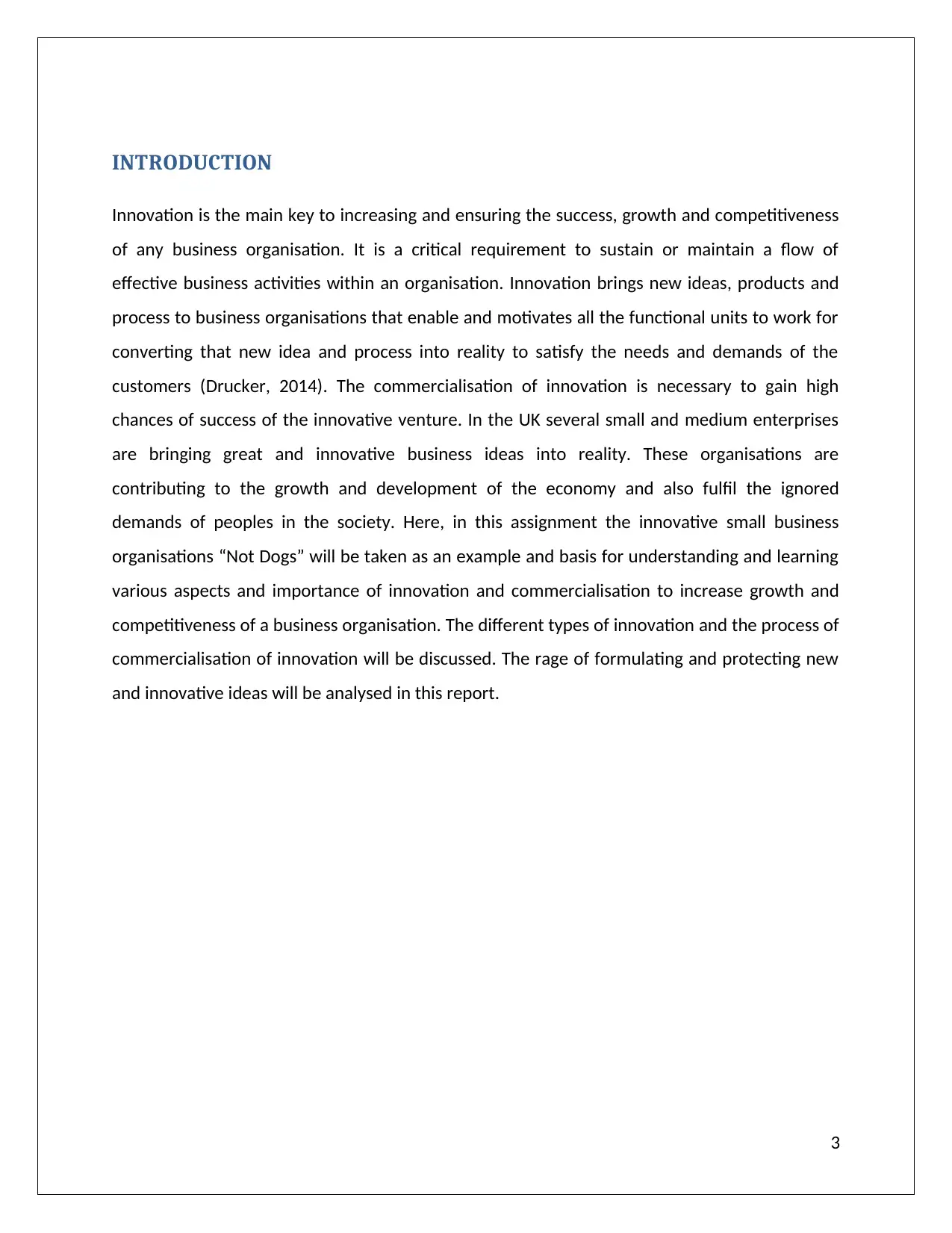
INTRODUCTION
Innovation is the main key to increasing and ensuring the success, growth and competitiveness
of any business organisation. It is a critical requirement to sustain or maintain a flow of
effective business activities within an organisation. Innovation brings new ideas, products and
process to business organisations that enable and motivates all the functional units to work for
converting that new idea and process into reality to satisfy the needs and demands of the
customers (Drucker, 2014). The commercialisation of innovation is necessary to gain high
chances of success of the innovative venture. In the UK several small and medium enterprises
are bringing great and innovative business ideas into reality. These organisations are
contributing to the growth and development of the economy and also fulfil the ignored
demands of peoples in the society. Here, in this assignment the innovative small business
organisations “Not Dogs” will be taken as an example and basis for understanding and learning
various aspects and importance of innovation and commercialisation to increase growth and
competitiveness of a business organisation. The different types of innovation and the process of
commercialisation of innovation will be discussed. The rage of formulating and protecting new
and innovative ideas will be analysed in this report.
3
Innovation is the main key to increasing and ensuring the success, growth and competitiveness
of any business organisation. It is a critical requirement to sustain or maintain a flow of
effective business activities within an organisation. Innovation brings new ideas, products and
process to business organisations that enable and motivates all the functional units to work for
converting that new idea and process into reality to satisfy the needs and demands of the
customers (Drucker, 2014). The commercialisation of innovation is necessary to gain high
chances of success of the innovative venture. In the UK several small and medium enterprises
are bringing great and innovative business ideas into reality. These organisations are
contributing to the growth and development of the economy and also fulfil the ignored
demands of peoples in the society. Here, in this assignment the innovative small business
organisations “Not Dogs” will be taken as an example and basis for understanding and learning
various aspects and importance of innovation and commercialisation to increase growth and
competitiveness of a business organisation. The different types of innovation and the process of
commercialisation of innovation will be discussed. The rage of formulating and protecting new
and innovative ideas will be analysed in this report.
3
Paraphrase This Document
Need a fresh take? Get an instant paraphrase of this document with our AI Paraphraser
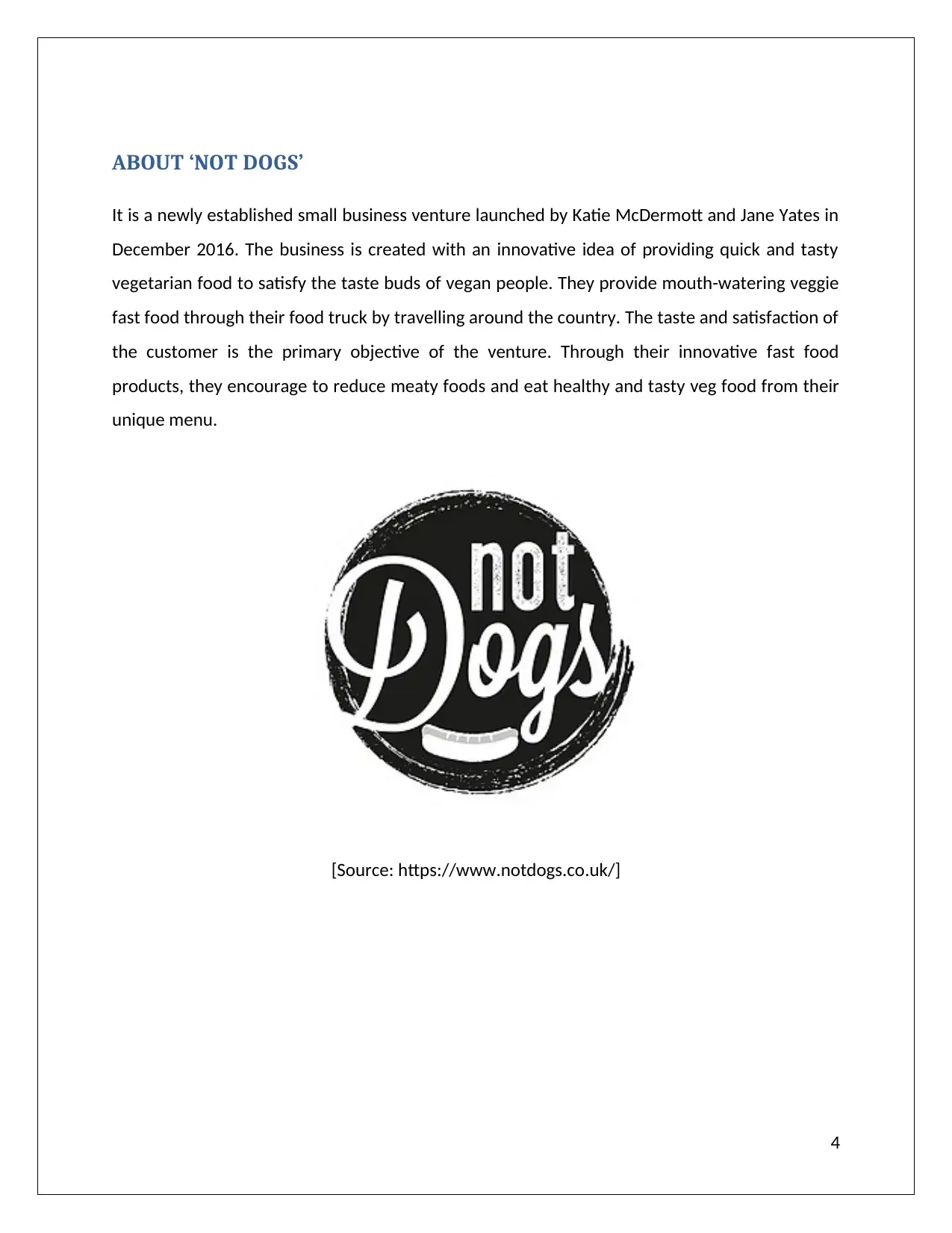
ABOUT ‘NOT DOGS’
It is a newly established small business venture launched by Katie McDermott and Jane Yates in
December 2016. The business is created with an innovative idea of providing quick and tasty
vegetarian food to satisfy the taste buds of vegan people. They provide mouth-watering veggie
fast food through their food truck by travelling around the country. The taste and satisfaction of
the customer is the primary objective of the venture. Through their innovative fast food
products, they encourage to reduce meaty foods and eat healthy and tasty veg food from their
unique menu.
[Source: https://www.notdogs.co.uk/]
4
It is a newly established small business venture launched by Katie McDermott and Jane Yates in
December 2016. The business is created with an innovative idea of providing quick and tasty
vegetarian food to satisfy the taste buds of vegan people. They provide mouth-watering veggie
fast food through their food truck by travelling around the country. The taste and satisfaction of
the customer is the primary objective of the venture. Through their innovative fast food
products, they encourage to reduce meaty foods and eat healthy and tasty veg food from their
unique menu.
[Source: https://www.notdogs.co.uk/]
4
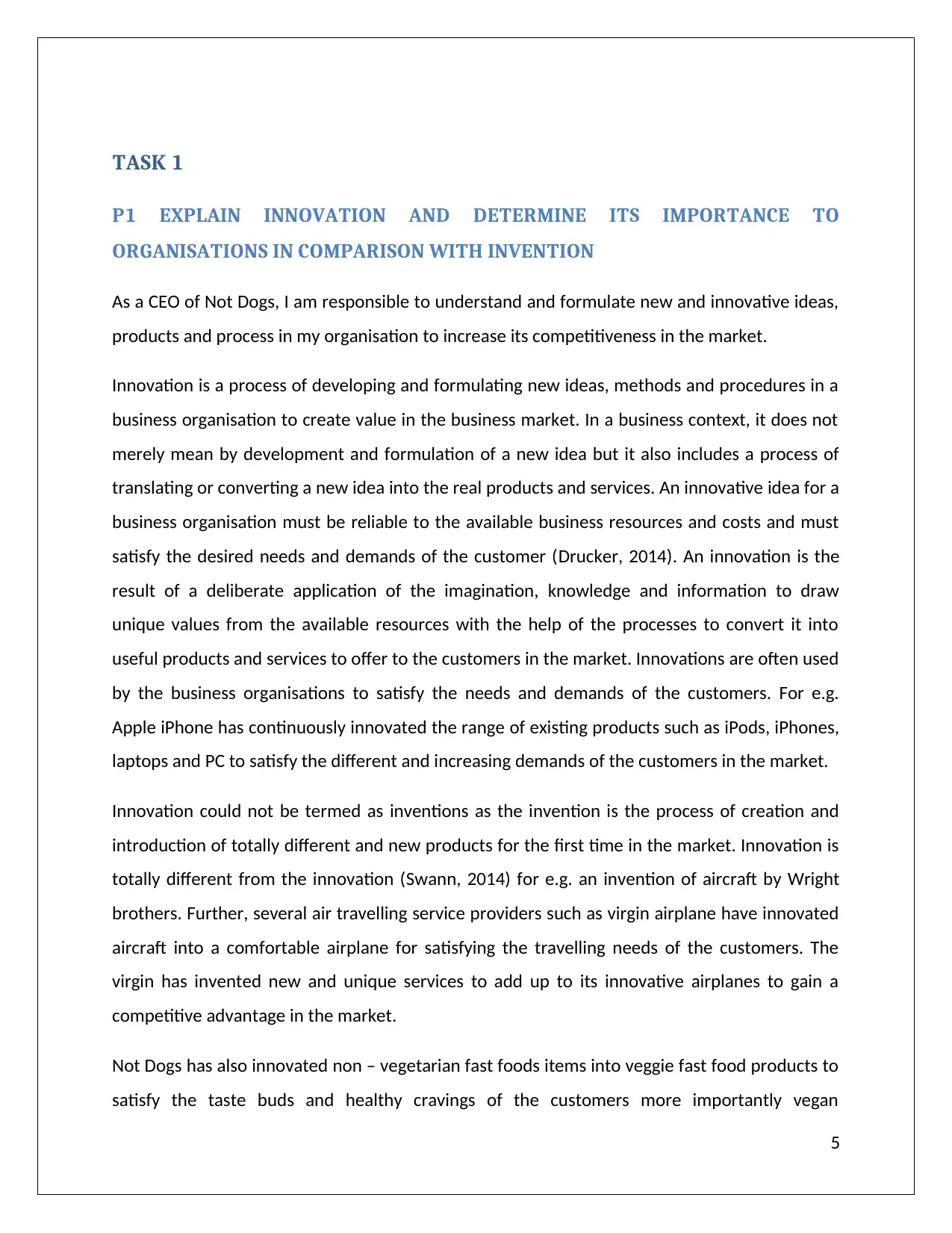
TASK 1
P1 EXPLAIN INNOVATION AND DETERMINE ITS IMPORTANCE TO
ORGANISATIONS IN COMPARISON WITH INVENTION
As a CEO of Not Dogs, I am responsible to understand and formulate new and innovative ideas,
products and process in my organisation to increase its competitiveness in the market.
Innovation is a process of developing and formulating new ideas, methods and procedures in a
business organisation to create value in the business market. In a business context, it does not
merely mean by development and formulation of a new idea but it also includes a process of
translating or converting a new idea into the real products and services. An innovative idea for a
business organisation must be reliable to the available business resources and costs and must
satisfy the desired needs and demands of the customer (Drucker, 2014). An innovation is the
result of a deliberate application of the imagination, knowledge and information to draw
unique values from the available resources with the help of the processes to convert it into
useful products and services to offer to the customers in the market. Innovations are often used
by the business organisations to satisfy the needs and demands of the customers. For e.g.
Apple iPhone has continuously innovated the range of existing products such as iPods, iPhones,
laptops and PC to satisfy the different and increasing demands of the customers in the market.
Innovation could not be termed as inventions as the invention is the process of creation and
introduction of totally different and new products for the first time in the market. Innovation is
totally different from the innovation (Swann, 2014) for e.g. an invention of aircraft by Wright
brothers. Further, several air travelling service providers such as virgin airplane have innovated
aircraft into a comfortable airplane for satisfying the travelling needs of the customers. The
virgin has invented new and unique services to add up to its innovative airplanes to gain a
competitive advantage in the market.
Not Dogs has also innovated non – vegetarian fast foods items into veggie fast food products to
satisfy the taste buds and healthy cravings of the customers more importantly vegan
5
P1 EXPLAIN INNOVATION AND DETERMINE ITS IMPORTANCE TO
ORGANISATIONS IN COMPARISON WITH INVENTION
As a CEO of Not Dogs, I am responsible to understand and formulate new and innovative ideas,
products and process in my organisation to increase its competitiveness in the market.
Innovation is a process of developing and formulating new ideas, methods and procedures in a
business organisation to create value in the business market. In a business context, it does not
merely mean by development and formulation of a new idea but it also includes a process of
translating or converting a new idea into the real products and services. An innovative idea for a
business organisation must be reliable to the available business resources and costs and must
satisfy the desired needs and demands of the customer (Drucker, 2014). An innovation is the
result of a deliberate application of the imagination, knowledge and information to draw
unique values from the available resources with the help of the processes to convert it into
useful products and services to offer to the customers in the market. Innovations are often used
by the business organisations to satisfy the needs and demands of the customers. For e.g.
Apple iPhone has continuously innovated the range of existing products such as iPods, iPhones,
laptops and PC to satisfy the different and increasing demands of the customers in the market.
Innovation could not be termed as inventions as the invention is the process of creation and
introduction of totally different and new products for the first time in the market. Innovation is
totally different from the innovation (Swann, 2014) for e.g. an invention of aircraft by Wright
brothers. Further, several air travelling service providers such as virgin airplane have innovated
aircraft into a comfortable airplane for satisfying the travelling needs of the customers. The
virgin has invented new and unique services to add up to its innovative airplanes to gain a
competitive advantage in the market.
Not Dogs has also innovated non – vegetarian fast foods items into veggie fast food products to
satisfy the taste buds and healthy cravings of the customers more importantly vegan
5
⊘ This is a preview!⊘
Do you want full access?
Subscribe today to unlock all pages.

Trusted by 1+ million students worldwide
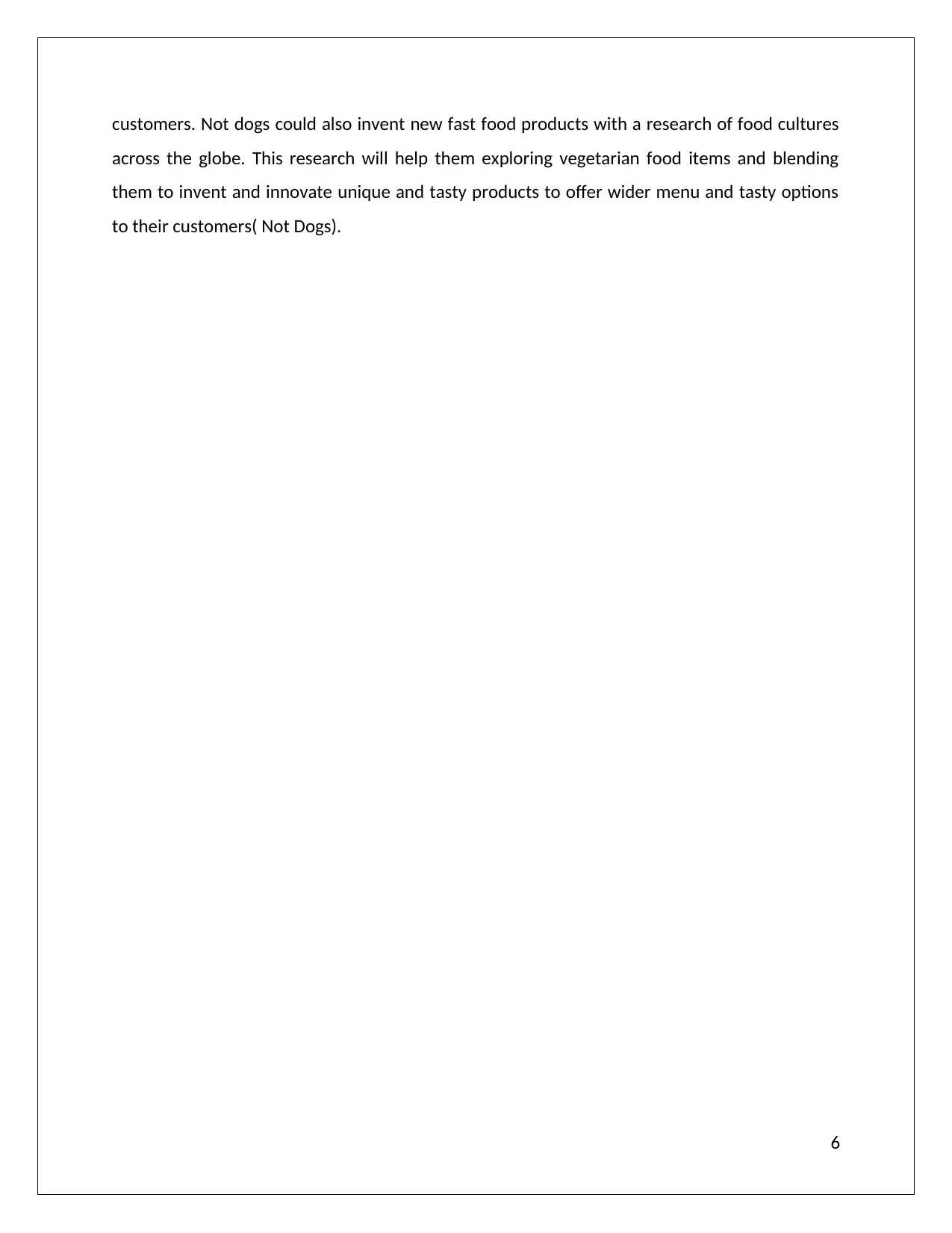
customers. Not dogs could also invent new fast food products with a research of food cultures
across the globe. This research will help them exploring vegetarian food items and blending
them to invent and innovate unique and tasty products to offer wider menu and tasty options
to their customers( Not Dogs).
6
across the globe. This research will help them exploring vegetarian food items and blending
them to invent and innovate unique and tasty products to offer wider menu and tasty options
to their customers( Not Dogs).
6
Paraphrase This Document
Need a fresh take? Get an instant paraphrase of this document with our AI Paraphraser
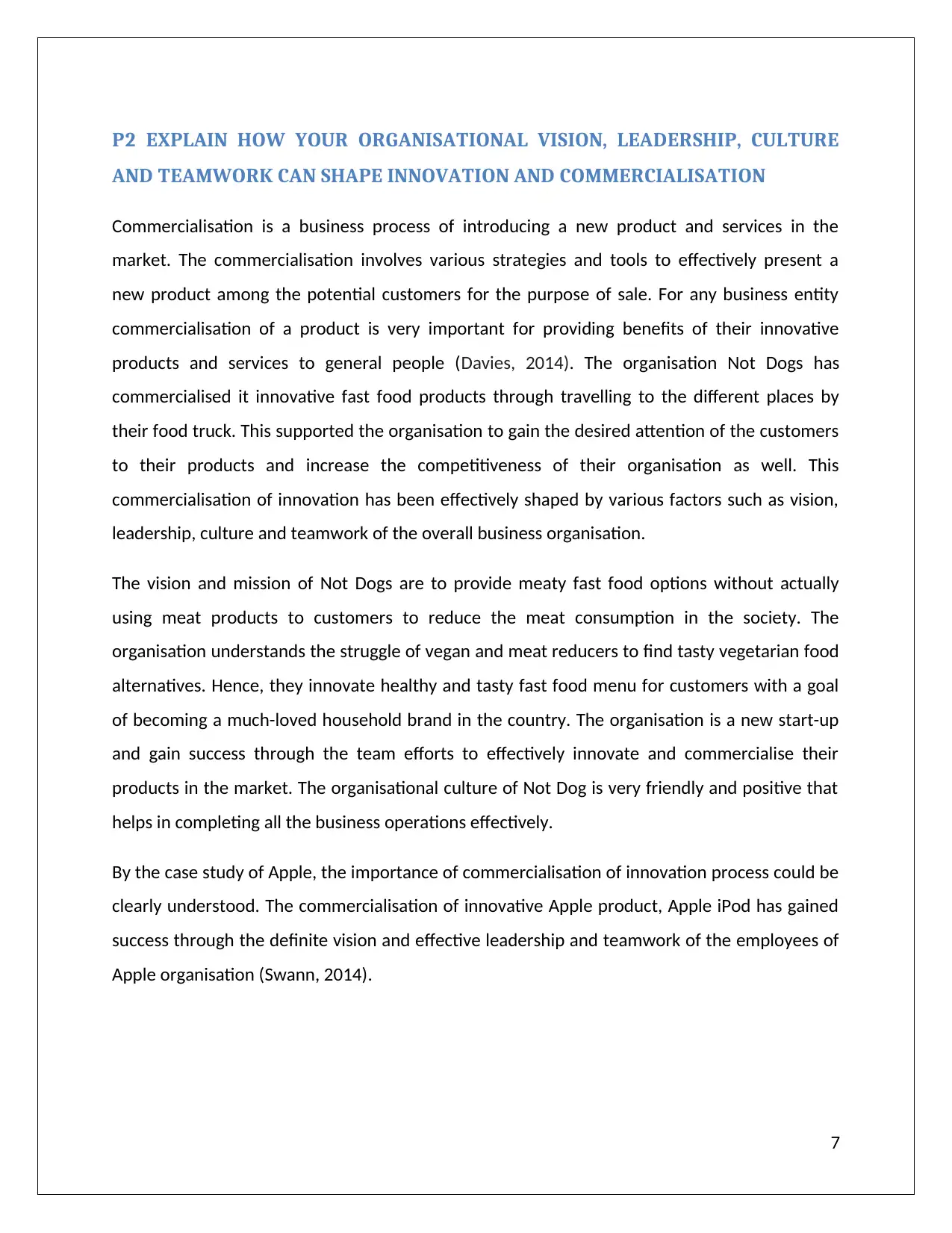
P2 EXPLAIN HOW YOUR ORGANISATIONAL VISION, LEADERSHIP, CULTURE
AND TEAMWORK CAN SHAPE INNOVATION AND COMMERCIALISATION
Commercialisation is a business process of introducing a new product and services in the
market. The commercialisation involves various strategies and tools to effectively present a
new product among the potential customers for the purpose of sale. For any business entity
commercialisation of a product is very important for providing benefits of their innovative
products and services to general people (Davies, 2014). The organisation Not Dogs has
commercialised it innovative fast food products through travelling to the different places by
their food truck. This supported the organisation to gain the desired attention of the customers
to their products and increase the competitiveness of their organisation as well. This
commercialisation of innovation has been effectively shaped by various factors such as vision,
leadership, culture and teamwork of the overall business organisation.
The vision and mission of Not Dogs are to provide meaty fast food options without actually
using meat products to customers to reduce the meat consumption in the society. The
organisation understands the struggle of vegan and meat reducers to find tasty vegetarian food
alternatives. Hence, they innovate healthy and tasty fast food menu for customers with a goal
of becoming a much-loved household brand in the country. The organisation is a new start-up
and gain success through the team efforts to effectively innovate and commercialise their
products in the market. The organisational culture of Not Dog is very friendly and positive that
helps in completing all the business operations effectively.
By the case study of Apple, the importance of commercialisation of innovation process could be
clearly understood. The commercialisation of innovative Apple product, Apple iPod has gained
success through the definite vision and effective leadership and teamwork of the employees of
Apple organisation (Swann, 2014).
7
AND TEAMWORK CAN SHAPE INNOVATION AND COMMERCIALISATION
Commercialisation is a business process of introducing a new product and services in the
market. The commercialisation involves various strategies and tools to effectively present a
new product among the potential customers for the purpose of sale. For any business entity
commercialisation of a product is very important for providing benefits of their innovative
products and services to general people (Davies, 2014). The organisation Not Dogs has
commercialised it innovative fast food products through travelling to the different places by
their food truck. This supported the organisation to gain the desired attention of the customers
to their products and increase the competitiveness of their organisation as well. This
commercialisation of innovation has been effectively shaped by various factors such as vision,
leadership, culture and teamwork of the overall business organisation.
The vision and mission of Not Dogs are to provide meaty fast food options without actually
using meat products to customers to reduce the meat consumption in the society. The
organisation understands the struggle of vegan and meat reducers to find tasty vegetarian food
alternatives. Hence, they innovate healthy and tasty fast food menu for customers with a goal
of becoming a much-loved household brand in the country. The organisation is a new start-up
and gain success through the team efforts to effectively innovate and commercialise their
products in the market. The organisational culture of Not Dog is very friendly and positive that
helps in completing all the business operations effectively.
By the case study of Apple, the importance of commercialisation of innovation process could be
clearly understood. The commercialisation of innovative Apple product, Apple iPod has gained
success through the definite vision and effective leadership and teamwork of the employees of
Apple organisation (Swann, 2014).
7
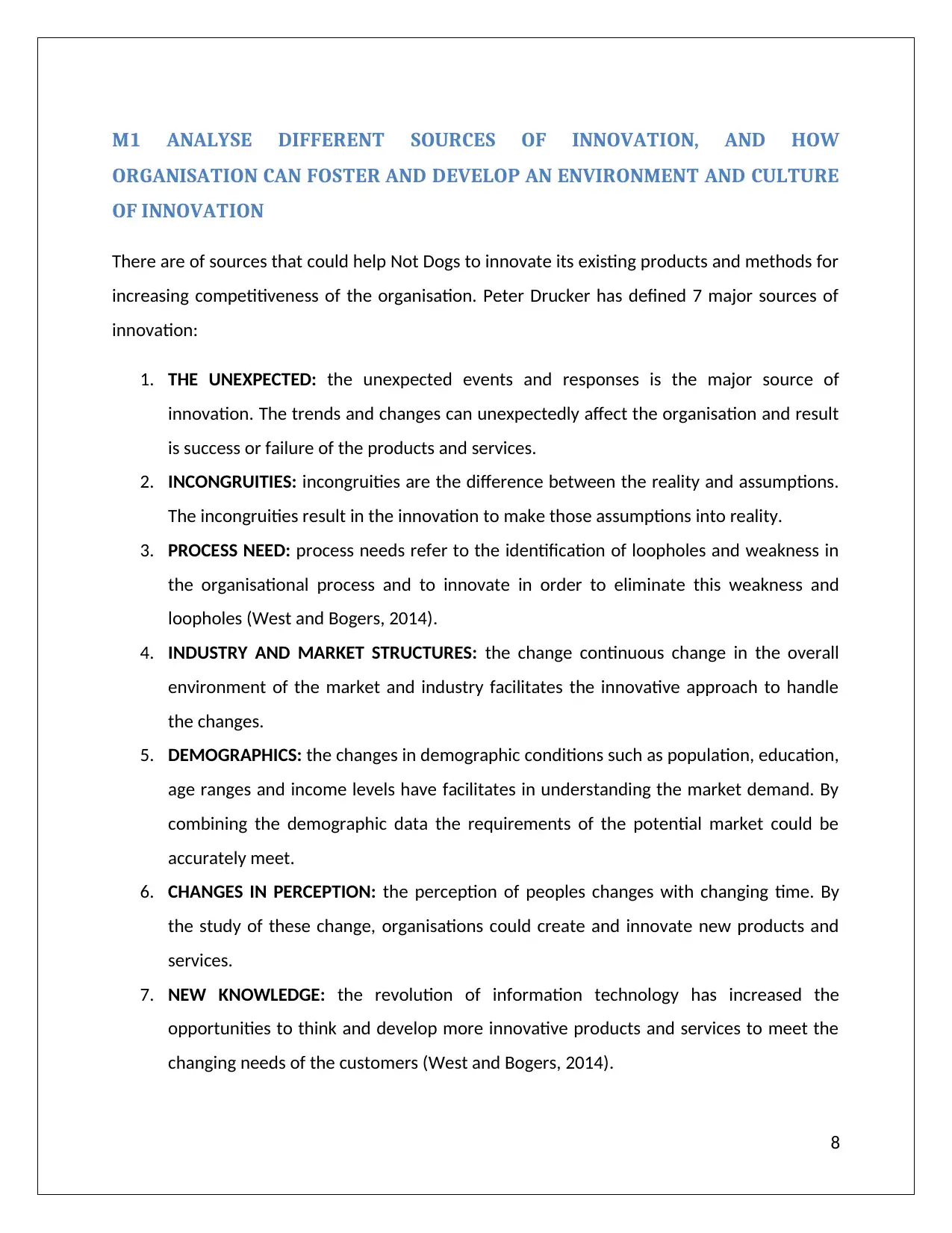
M1 ANALYSE DIFFERENT SOURCES OF INNOVATION, AND HOW
ORGANISATION CAN FOSTER AND DEVELOP AN ENVIRONMENT AND CULTURE
OF INNOVATION
There are of sources that could help Not Dogs to innovate its existing products and methods for
increasing competitiveness of the organisation. Peter Drucker has defined 7 major sources of
innovation:
1. THE UNEXPECTED: the unexpected events and responses is the major source of
innovation. The trends and changes can unexpectedly affect the organisation and result
is success or failure of the products and services.
2. INCONGRUITIES: incongruities are the difference between the reality and assumptions.
The incongruities result in the innovation to make those assumptions into reality.
3. PROCESS NEED: process needs refer to the identification of loopholes and weakness in
the organisational process and to innovate in order to eliminate this weakness and
loopholes (West and Bogers, 2014).
4. INDUSTRY AND MARKET STRUCTURES: the change continuous change in the overall
environment of the market and industry facilitates the innovative approach to handle
the changes.
5. DEMOGRAPHICS: the changes in demographic conditions such as population, education,
age ranges and income levels have facilitates in understanding the market demand. By
combining the demographic data the requirements of the potential market could be
accurately meet.
6. CHANGES IN PERCEPTION: the perception of peoples changes with changing time. By
the study of these change, organisations could create and innovate new products and
services.
7. NEW KNOWLEDGE: the revolution of information technology has increased the
opportunities to think and develop more innovative products and services to meet the
changing needs of the customers (West and Bogers, 2014).
8
ORGANISATION CAN FOSTER AND DEVELOP AN ENVIRONMENT AND CULTURE
OF INNOVATION
There are of sources that could help Not Dogs to innovate its existing products and methods for
increasing competitiveness of the organisation. Peter Drucker has defined 7 major sources of
innovation:
1. THE UNEXPECTED: the unexpected events and responses is the major source of
innovation. The trends and changes can unexpectedly affect the organisation and result
is success or failure of the products and services.
2. INCONGRUITIES: incongruities are the difference between the reality and assumptions.
The incongruities result in the innovation to make those assumptions into reality.
3. PROCESS NEED: process needs refer to the identification of loopholes and weakness in
the organisational process and to innovate in order to eliminate this weakness and
loopholes (West and Bogers, 2014).
4. INDUSTRY AND MARKET STRUCTURES: the change continuous change in the overall
environment of the market and industry facilitates the innovative approach to handle
the changes.
5. DEMOGRAPHICS: the changes in demographic conditions such as population, education,
age ranges and income levels have facilitates in understanding the market demand. By
combining the demographic data the requirements of the potential market could be
accurately meet.
6. CHANGES IN PERCEPTION: the perception of peoples changes with changing time. By
the study of these change, organisations could create and innovate new products and
services.
7. NEW KNOWLEDGE: the revolution of information technology has increased the
opportunities to think and develop more innovative products and services to meet the
changing needs of the customers (West and Bogers, 2014).
8
⊘ This is a preview!⊘
Do you want full access?
Subscribe today to unlock all pages.

Trusted by 1+ million students worldwide
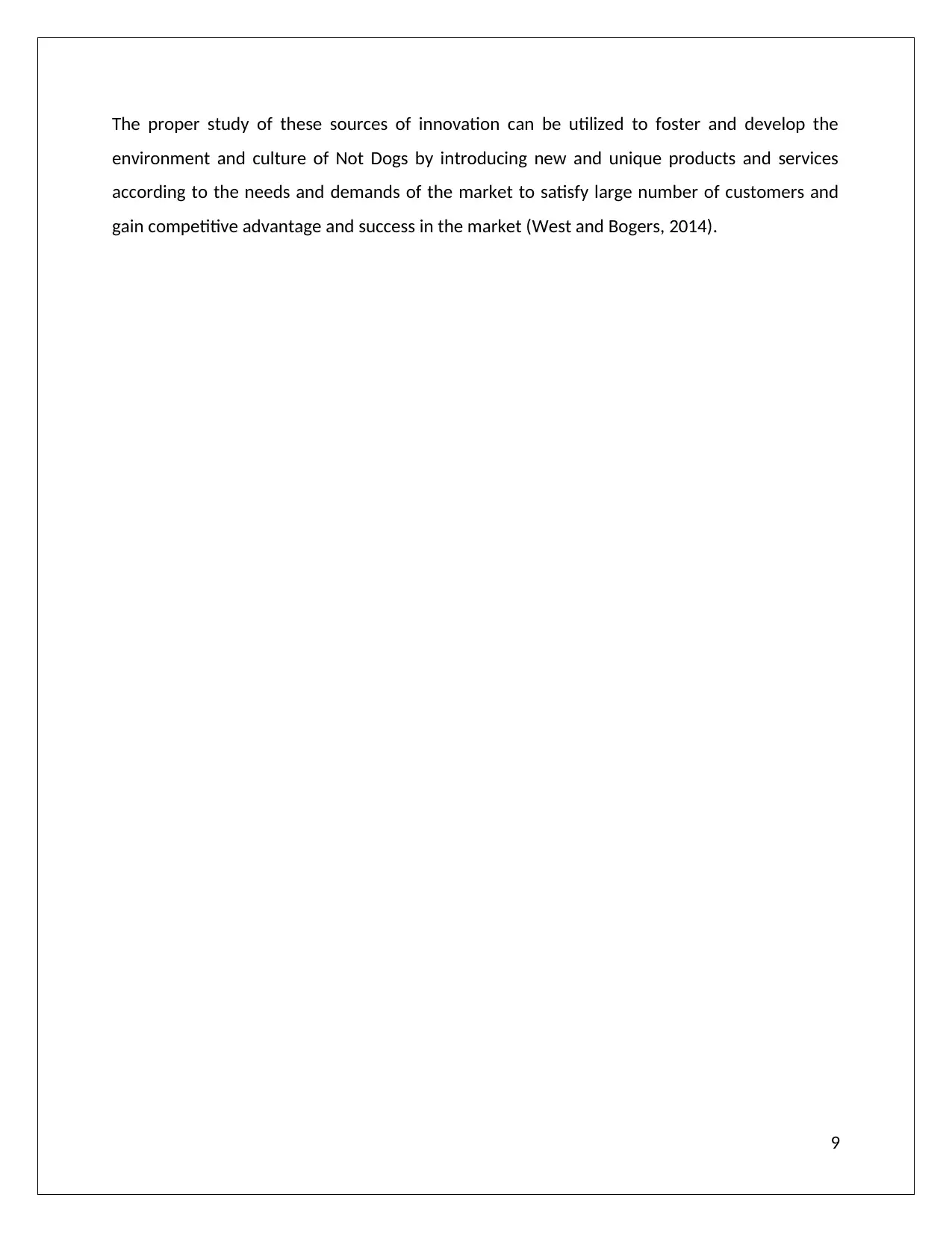
The proper study of these sources of innovation can be utilized to foster and develop the
environment and culture of Not Dogs by introducing new and unique products and services
according to the needs and demands of the market to satisfy large number of customers and
gain competitive advantage and success in the market (West and Bogers, 2014).
9
environment and culture of Not Dogs by introducing new and unique products and services
according to the needs and demands of the market to satisfy large number of customers and
gain competitive advantage and success in the market (West and Bogers, 2014).
9
Paraphrase This Document
Need a fresh take? Get an instant paraphrase of this document with our AI Paraphraser
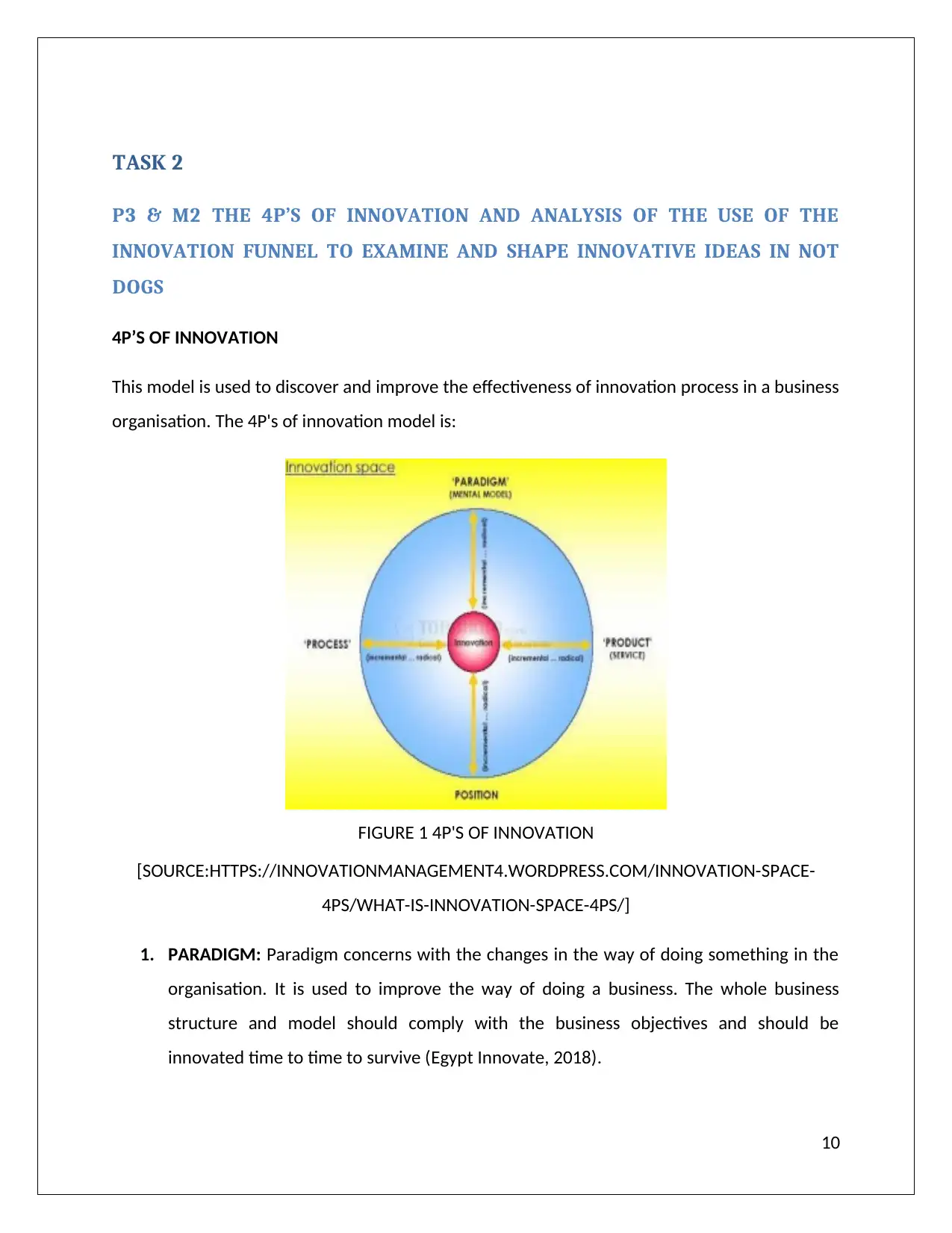
TASK 2
P3 & M2 THE 4P’S OF INNOVATION AND ANALYSIS OF THE USE OF THE
INNOVATION FUNNEL TO EXAMINE AND SHAPE INNOVATIVE IDEAS IN NOT
DOGS
4P’S OF INNOVATION
This model is used to discover and improve the effectiveness of innovation process in a business
organisation. The 4P's of innovation model is:
FIGURE 1 4P'S OF INNOVATION
[SOURCE:HTTPS://INNOVATIONMANAGEMENT4.WORDPRESS.COM/INNOVATION-SPACE-
4PS/WHAT-IS-INNOVATION-SPACE-4PS/]
1. PARADIGM: Paradigm concerns with the changes in the way of doing something in the
organisation. It is used to improve the way of doing a business. The whole business
structure and model should comply with the business objectives and should be
innovated time to time to survive (Egypt Innovate, 2018).
10
P3 & M2 THE 4P’S OF INNOVATION AND ANALYSIS OF THE USE OF THE
INNOVATION FUNNEL TO EXAMINE AND SHAPE INNOVATIVE IDEAS IN NOT
DOGS
4P’S OF INNOVATION
This model is used to discover and improve the effectiveness of innovation process in a business
organisation. The 4P's of innovation model is:
FIGURE 1 4P'S OF INNOVATION
[SOURCE:HTTPS://INNOVATIONMANAGEMENT4.WORDPRESS.COM/INNOVATION-SPACE-
4PS/WHAT-IS-INNOVATION-SPACE-4PS/]
1. PARADIGM: Paradigm concerns with the changes in the way of doing something in the
organisation. It is used to improve the way of doing a business. The whole business
structure and model should comply with the business objectives and should be
innovated time to time to survive (Egypt Innovate, 2018).
10
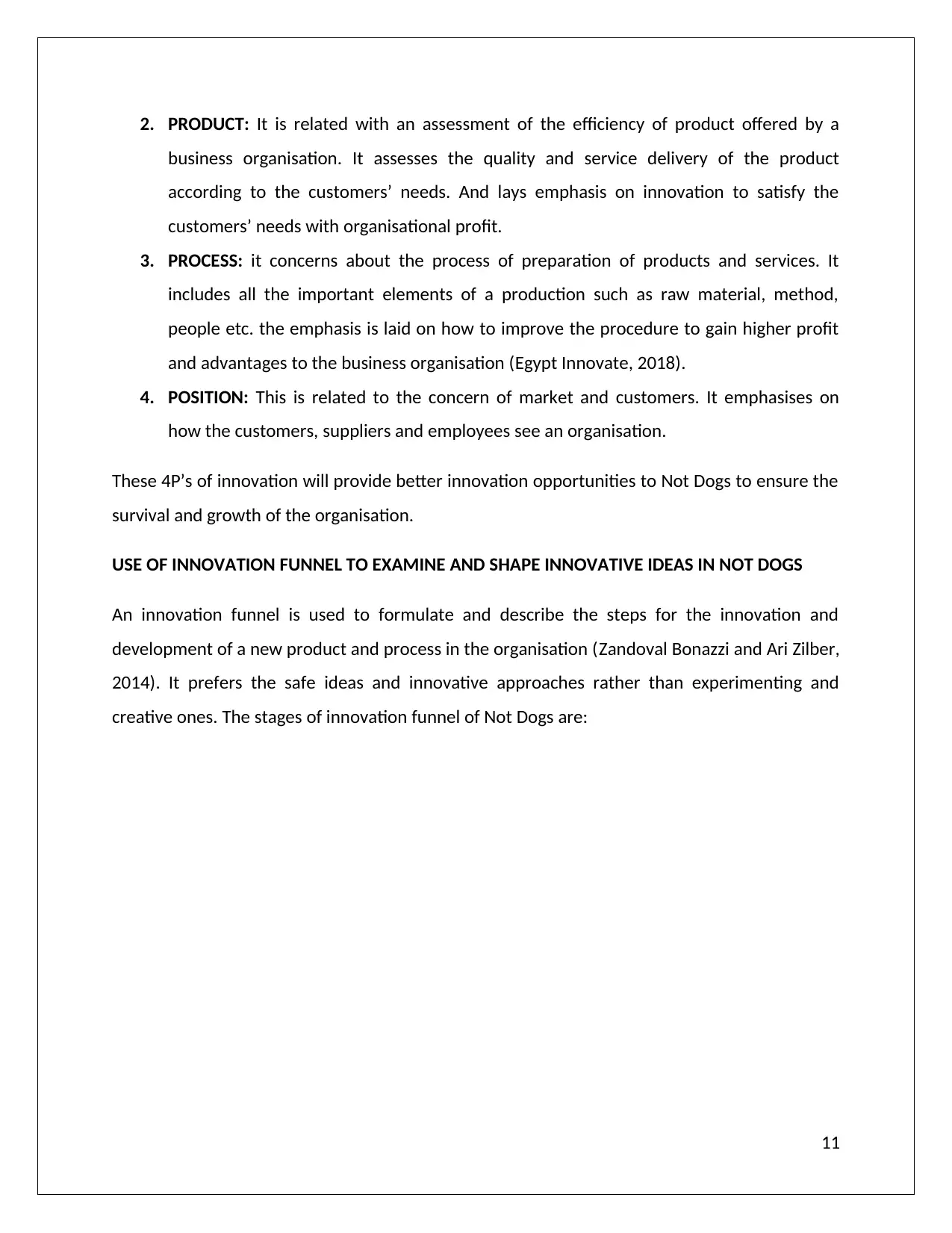
2. PRODUCT: It is related with an assessment of the efficiency of product offered by a
business organisation. It assesses the quality and service delivery of the product
according to the customers’ needs. And lays emphasis on innovation to satisfy the
customers’ needs with organisational profit.
3. PROCESS: it concerns about the process of preparation of products and services. It
includes all the important elements of a production such as raw material, method,
people etc. the emphasis is laid on how to improve the procedure to gain higher profit
and advantages to the business organisation (Egypt Innovate, 2018).
4. POSITION: This is related to the concern of market and customers. It emphasises on
how the customers, suppliers and employees see an organisation.
These 4P’s of innovation will provide better innovation opportunities to Not Dogs to ensure the
survival and growth of the organisation.
USE OF INNOVATION FUNNEL TO EXAMINE AND SHAPE INNOVATIVE IDEAS IN NOT DOGS
An innovation funnel is used to formulate and describe the steps for the innovation and
development of a new product and process in the organisation (Zandoval Bonazzi and Ari Zilber,
2014). It prefers the safe ideas and innovative approaches rather than experimenting and
creative ones. The stages of innovation funnel of Not Dogs are:
11
business organisation. It assesses the quality and service delivery of the product
according to the customers’ needs. And lays emphasis on innovation to satisfy the
customers’ needs with organisational profit.
3. PROCESS: it concerns about the process of preparation of products and services. It
includes all the important elements of a production such as raw material, method,
people etc. the emphasis is laid on how to improve the procedure to gain higher profit
and advantages to the business organisation (Egypt Innovate, 2018).
4. POSITION: This is related to the concern of market and customers. It emphasises on
how the customers, suppliers and employees see an organisation.
These 4P’s of innovation will provide better innovation opportunities to Not Dogs to ensure the
survival and growth of the organisation.
USE OF INNOVATION FUNNEL TO EXAMINE AND SHAPE INNOVATIVE IDEAS IN NOT DOGS
An innovation funnel is used to formulate and describe the steps for the innovation and
development of a new product and process in the organisation (Zandoval Bonazzi and Ari Zilber,
2014). It prefers the safe ideas and innovative approaches rather than experimenting and
creative ones. The stages of innovation funnel of Not Dogs are:
11
⊘ This is a preview!⊘
Do you want full access?
Subscribe today to unlock all pages.

Trusted by 1+ million students worldwide
1 out of 26
Related Documents
Your All-in-One AI-Powered Toolkit for Academic Success.
+13062052269
info@desklib.com
Available 24*7 on WhatsApp / Email
![[object Object]](/_next/static/media/star-bottom.7253800d.svg)
Unlock your academic potential
Copyright © 2020–2025 A2Z Services. All Rights Reserved. Developed and managed by ZUCOL.





